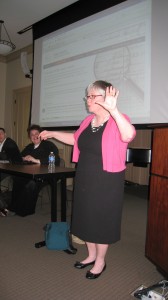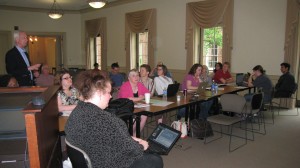
Expert Panel (from left): Kenton McHenry, Stephen Robertson, Emily Stanford Schultz and Connie Potter
On Tuesday, April 10, more than sixty people helped the Digital Innovation Lab celebrate the release of the 1940 census records. For the first time ever, the records were released in digital form. We brought in four experts representing very different perspectives on the census to talk about the implications of using digital records at this scale.
Connie Potter of the National Archives and Records Administration kicked off the roundtable by presenting historical context for the 1940 census.
She explained many of the fields in the census schedule and discussed some of the questions that had been dropped from the previous census.
Kenton McHenry of the National Center for Supercomputing Applications talked about the challenge of making millions of handwritten records searchable at scale. His team is working on applying Optical Character Recognition (OCR) technology to handwriting in a way that can scale up to handle this “big data” set. View PowerPoint.
Stephen Robertson of the University of Sydney and co-author of Digital Harlem provided a historian’s perspective on the 1940 census. Rather than using the census for genealogical purposes to search for people, he suggested using the census to locate place. Reading census records across time, as he demonstrated, can reveal a lot about the built environment and its occupants. Thus the census can be used to tell a story not just about people, but about places as well. View PowerPoint: Robertson_Putting_the_Census_in_Place. Read the text of his talk here.
Emily Stanford Schultz of FamilySearch.org rounded out the panel by discussing FamilySearch’s efforts to index the 1940 census by crowdsourcing. Currently, the only way to search the census is by location, which requires knowing the enumeration district. Many groups are looking to index the census – to create a name database to make the digital records searchable. FamilySearch’s work to index centers on community participation. View PowerPoint.
Later that day, Emily and Connie returned to speak at a smaller workshop. Connie gave additional context about the census, while Emily demonstrated FamilySearch’s indexing tool. They were joined by Digital Innovation Lab co-directory Robert Allen, who talked about some of the ways he has used the census in the classroom.
For more information about this event, see the original announcement or visit the official site of the 1940 Census.




